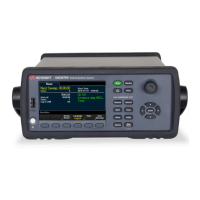CALCulate:LIMit:{LOWer|UPPer}:STATe {OFF | ON} [, (@<ch_list>)]
CALCulate:LIMit:{LOWer|UPPer}:STATe? [(@<ch_list>)]
Enables or disables the lower and upper alarm limits on the specified channels during a scan.
This command is not supported in DMM Digitize data acquisition mode.
Error -221,"Settings conflict; DMM digitizing mode has been disabled" will be generated when you send the
command to enable the lower limit state or upper limit state.
Parameter Typical return
{OFF | ON}
Default: OFF
0 (OFF) or 1 (ON)
Sets an upper limit on channels 03 and 13 in slot 1 and then enables alarms on these channels:
CALC:LIM:UPP 10.25,(@103,113)
CALC:LIM:UPP:STAT ON,(@103,113)
In this example, you can replace the UPP node with LOW.
– Alarm data can be saved in one of two locations depending on whether a scan list is running when the alarm
occurs.
– If an alarm event occurs on a channel as it is being scanned, then that channel's alarm status is saved in read-
ing memory as the readings are taken. Each reading that is outside the specified alarm limit is logged in read-
ing memory. You can save at least 100,000 readings in reading memory during a scan.
– As alarm events are generated, they are also logged in an alarm queue, which is separate from reading
memory. This is the only place that non-scanned alarms get logged (alarms during a channel monitor, alarms
generated by the digital modules, etc.). Up to 20 alarms can be logged in the alarm queue. If more than 20
alarm events are generated, they will be lost (only the first 20 alarms are saved). Even if the alarm queue is full,
the alarm status is saved in reading memory during a scan.
– You cannot configure the alarm when the internal DMM is disabled (see INSTrument:DMM command).
– To generate an alarm when a specific count is reached (high limit) is reached on a totalizer channel, use the
CALCulate:LIMit:UPPer command. If you use alarms on the totalizer channel with the measurement scaling, the
alarm limits will only evaluated according to the initial scanned reading, scaled reading will not affect the alarms
evaluations on totalizer channel.
– To generate an alarm when a specific bit pattern or bit pattern change is detected on a digital input channel, see
the CALCulate:COMPare commands.
– When an alarm occurs, the instrument stores relevant information about the alarm in the queue. This includes
the reading that triggered the alarm, the time of day and date of the alarm, and the channel number on which
the alarm occurred. The information stored in the alarm queue is always in absolute time and is not affected by
the FORMat:READing:TIME:TYPE command setting.
Keysight DAQ970A/DAQ973A Programming Guide 69
2 SCPI Programming

